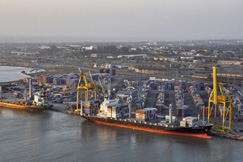South Africa has a role in post-conflict development
20 February
The important role that regional organisations can play in matters of peace and
security has long been recognised. In Africa, the regional economic communities are
increasingly taking on a role in responding to matters of peace and security, including
post-conflict reconstruction and development (PCRD).
However, as intra-state conflict rises, spills over borders and often resurges after
appearing to die down, implementing PCRD remains a daunting challenge. The
Southern African Development Community (SADC) is an important actor in matters of
peace and security, but, at present, it lacks the capacity to implement PCRD.
A new paper by the Institute for Security Studies (ISS) finds that while there is some
opportunity for South Africa to enhance and facilitate PCRD through SADC, the
organisation must first overcome a number of challenges.
South Africa plays a significant role in matters of peace and security on the African
continent. It contributed to the evolution of the African Union (AU) and the African
Peace and Security Architecture, and also facilitated the AU's decision to establish
the African Capacity for Immediate Response to Crises. South Africa was also
involved in various mediation efforts as a member of SADC, notably in Zimbabwe’s
post-2012 electoral crisis and Madagascar's constitutional mediation process. Even
so, South Africa's ability to implement PCRD in the region through its SADC
membership has been constrained for various reasons.
Firstly, it has to manage perceptions over its actions within SADC, so as not to
arouse accusations of hegemony. Secondly, South Africa is inadequately represented
within SADC structures. This could be attributed to a combination of SADC staffing
rules, diplomats' perceptions of Gaborone not being a prime posting, and South
Africa's tendency to be inconsistent in its foreign policy. Thirdly, SADC espouses a
state-centric,
rather than human-centric definition of security. This makes post-
conflict development difficult even at a conceptual level.
In addition to this, SADC's main policy documents – namely the Regional Indicative
Strategic Development Plan (RISDP) and the Strategic Indicative Plan for the Organ
(SIPO) – do not provide an easy basis from which to operate. Both of these have
undergone review and version two of SIPO has already been adopted. The
documents are long, extremely ambitious, and would arguably be better if merged
into one.
To an extent, both the RISDP and SIPO II focus on promoting peace and security
through integration.
There are a number of opportunities for South Africa to implement PCRD through
SADC. South Africa has an impressive track record in conflict resolution; it has the
largest economy of all the SADC member states; and also has substantial military
power and experience to offer SADC. South Africa is also establishing the South
African Development Partnership Agency, which could potentially partner with the
SADC Development Fund for implementing PCRD.
As the current head of the SADC Organ on Politics, Defence and Security Co-
operation, South Africa should use this opportunity to positively influence the
organisation and involve more of the member states to achieve a SADC brand (as
opposed to an individual member-state brand) of multilateral PCRD implementation.
However, in moving forward, South Africa must also clarify its commitment to SADC
through solid foreign-policy actions, such as sending well-trained diplomats to
Gaborone.
If SADC is to move forward, it needs to find a real post-liberation middle ground and
achieve a unified agenda from which the organisation can operate.
It is critical that SADC better communicates with international partners – once again
an area where South Africa can provide valuable technical assistance, based on its
domestic experience
of establishing the Department of Performance Monitoring and
Evaluation.
While there is certainly a lot that South Africa can offer SADC, it also needs to
demonstrate that it is committed to the organisation beyond merely incorporating
that commitment in its foreign policy documents. As soon as SADC establishes a clear
and logical policy basis from which to operate, it can also make great strides in its
ability to respond to matters of peace and security in the region.
Source: Institute for Security
Studies
 Port of Maputo, Mozambique (Image: Port Maputo)
Port of Maputo, Mozambique (Image: Port Maputo)
 Port of Maputo, Mozambique (Image: Port Maputo)
Port of Maputo, Mozambique (Image: Port Maputo)